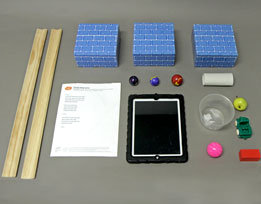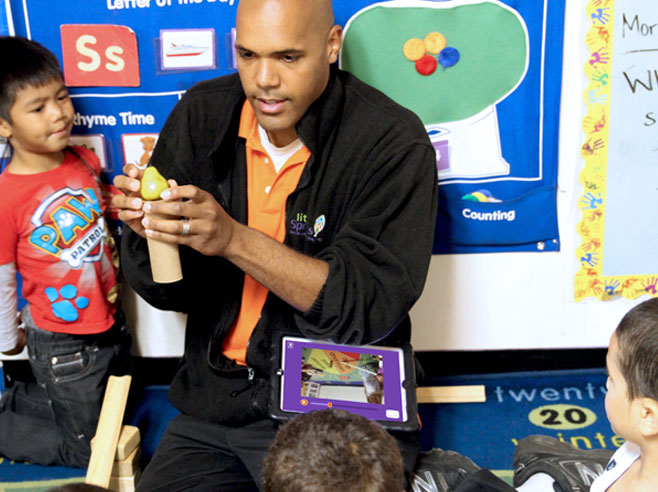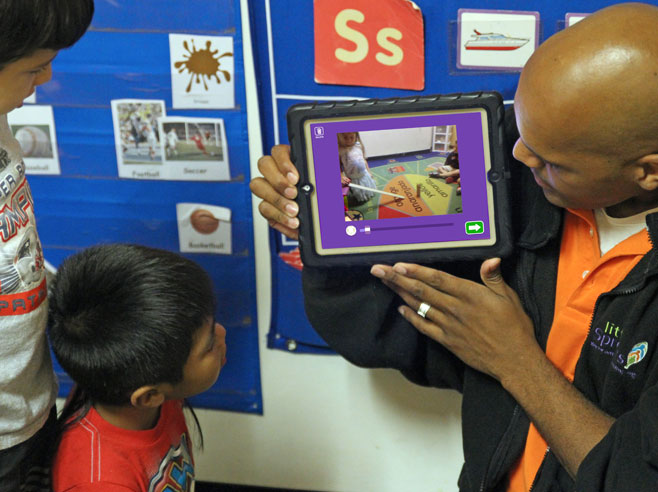Children predict what will happen when a rolling marble hits an obstacle and explain their reasoning. Then they watch several videos from the Slow It Down Videos tool and observe what happens.
Materials

- Large or extra-large marble
- Obstacles used in the Ready, Set, Roll the Marble videos you will be watching
- Ramps Journal app on the iPads used during Guided Small Group sessions
- Ramp materials, such as cove molding, paper towel tubes, cardboard blocks
- Optional: Projector (if available)
Preparation
- Select two to four slow-motion Ready, Set, Roll the Marble videos from the Slow It Down Videos digital tool to share with the class. Choose videos that show different obstacles.
- Gather materials to reconstruct the obstacles used in the videos you’ve selected.
- If using, set up a projector to display the iPad.
Directions: Lesson 7
Digital Learning Center
- Invite children to rewatch the slow-motion Ready, Set, Roll the Marble videos from the Slow It Down Videos digital tool taken during the Ready, Set, Roll the Marble: Experiments Guided Small Group activity. Encourage them to closely observe what happens.
- As you stop by this learning center, engage children in conversation describing the movement of the marble and the obstacles, the force of gravity moving the marble, and the force of the marble moving the obstacles. Use similar prompts as those used in Ready, Set, Roll the Marble: Experiments, such as:
- What do you predict will happen to the marble when it hits this obstacle? Will it stop? Slow down? Change direction?
- What do you predict will happen to this obstacle when it is hit by the marble?
Circle Time: Wrap-Up
- Have children recall and describe their experiments from the Ready, Set, Roll the Marble: Experiments Guided Small Group activity. Encourage all children to discuss the experiments. Possible discussion ideas:
- What obstacles did your group use in your Ready, Set, Roll the Marble experiments?
- What happened to the marble when it hit the obstacle?
- What happened to the obstacle when the marble hit it?
- What happened when you made the ramp steeper so the marble would hit the obstacle with a bigger force?
- Display the image of the obstacle from the first slow-motion Ready, Set, Roll the Marble video that you have selected. Ask children to predict what will happen to the marble when it hits the obstacle and what will happen to the obstacle.
- Watch the video and ask children to observe and describe what happens. Were their predictions correct?
- You may want to rewatch the video and use the pause button to focus on specific actions and reactions.
- Now have children help you construct a ramp as steep as the one in the video and place an obstacle in front of it. If we roll a marble down the ramp to hit the obstacle, do you think the same things will happen as happened in the video?
- Roll the marble down the ramp and see what happens when the obstacle is hit by the marble. How is it the same as in the video? How is it different?
- Repeat these steps (predict, observe, try it again) with the other videos and obstacle props you have selected.
SAFETY ALERT: Marbles can be a choking hazard to children. Make sure children understand that they are never to put marbles in their mouths. Monitor children when they are playing with marbles to ensure that they are using them responsibly and safely.


